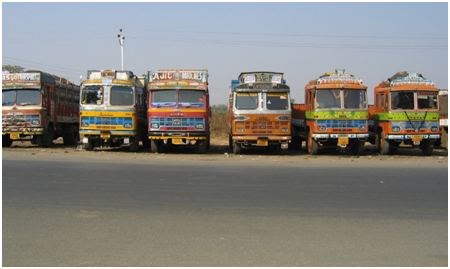
According to
information from the Centre for Monitoring Indian Economy (CMIE), this incremental rise in freight rates
underscores the complex interplay of various factors impacting the
transportation sector. Considering that the trucking sector plays a
significant role in meeting domestic freight demand – accounting for 70% of the
total in 2022 – a surge in freight rates may become a point of concern.
The CMIE
analysis, which calculates expenses on a per-kilometer basis for transporting
goods using 15-tonne capacity trucks, revealed that freight rates from Delhi to
various metro destinations, including Mumbai, Kolkata, Bangalore, and Chennai,
have seen a significant year-on-year rise in prices.
Furthermore, this upward trend was
not confined to major metros alone and smaller trade centers also experienced
increases in trucking rates. Delhi to Patna rates were up by 8%, Delhi to Guwahati
by 1%, and Delhi to Hyderabad by 2.1%. Notably, the Delhi to Sirsa route
witnessed a significant surge of 14.5%.However,
contrary to this increase, some routes witnessed a decline in rates.
Bhopal, Lucknow, Thiruvananthapuram, Bhubaneswar, and Jaipur recorded declines,
while rates in Ahmedabad and Dehradun have remained unchanged.The surge in trucking rates comes against
the backdrop of recent disruptions in the sector. These factors range from
increased demand for transportation services to regulatory changes and supply
chain disruptions. For instance, in January, truck drivers initiated protests
against the penalties mentioned for hit-and-run cases under the new Bharatiya
Nyaya Sanhita (BNS).
As elucidated
by industry experts, including Mr. Chirag Katira (General Secretary –
Maharashtra, AIMTC and Director, SNGT)
these dynamics are reshaping the logistics ecosystem, presenting both
challenges and opportunities for stakeholders. Chirag’s analysis sheds
light on the intricate web of factors contributing to the surge in freight
rates. Increased demand, driven by factors such as e-commerce growth and
globalization, has strained the supply chain. This demand surge has led to a
rise in fuel costs, as transportation companies grapple with higher expenses to
keep their fleets operational. Additionally,
the industry is facing a shortage of drivers, exacerbating the challenges in
meeting the growing demand for freight services. Furthermore, regulatory
changes have also played a role in the upward pressure on freight rates.
Stringent emission standards and safety regulations have increased the
operational costs for transportation companies, which are passed on to
customers in the form of higher freight rates. These factors collectively
contribute to the complex dynamics of the freight industry…Coming to the
question of why the trend is being noticed specifically in metro cities, it can
be safely said that urban centers
experience a more pronounced change in freight rates due to their higher
population density, increased economic activity, and greater demand for goods
and services….We asked Chirag if the month of February holds a certain
significance on the timeline. He said
that the surge in this month is influenced by seasonal factors such as
heightened demand post-holiday season and adverse weather conditions.
“Ongoing supply chain challenges, recent regulatory changes, and impending
accounting year closing also contribute to the upward trend in freight rates
during this period,” he added.
The surge in
trucking rates underscores the need for
continued dialogue and collaboration between industry players and policymakers
to ensure the smooth functioning of the logistics sector.